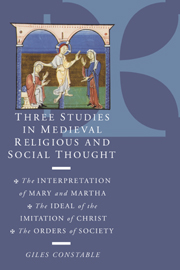 Three Studies in Medieval Religious and Social Thought
Three Studies in Medieval Religious and Social Thought Book contents
- Frontmatter
- Contents
- List of illustrations
- Preface
- List of abbreviations
- I THE INTERPRETATION OF MARY AND MARTHA
- II THE IDEAL OF THE IMITATION OF CHRIST
- The imitation of the divinity of Christ
- The imitation of the humanity of Christ
- The imitation of the body of Christ
- The late Middle Ages
- III THE ORDERS OF SOCIETY
- Bibliography of secondary works
- Index of manuscripts
- Biblical index
- General index
The imitation of the body of Christ
Published online by Cambridge University Press: 08 December 2009
- Frontmatter
- Contents
- List of illustrations
- Preface
- List of abbreviations
- I THE INTERPRETATION OF MARY AND MARTHA
- II THE IDEAL OF THE IMITATION OF CHRIST
- The imitation of the divinity of Christ
- The imitation of the humanity of Christ
- The imitation of the body of Christ
- The late Middle Ages
- III THE ORDERS OF SOCIETY
- Bibliography of secondary works
- Index of manuscripts
- Biblical index
- General index
Summary
the desire to imitate Christ's body, and especially His sufferings, was closely related to the imitation both of His humanity and of His divinity, since the passion and the crucifixion were the essential preparations for the resurrection and thus set an example for all Christians. Even in the early church, when the primary concern was with the imitation of Christ's divinity, some writers expressed a sympathy (in the strict sense of the word) with His human sufferings, and some of the expressions of tenderness and endearment for the human Jesus in Syria in the fifth to seventh centuries and in Ireland in the eighth to eleventh centuries resembled those on the continent in the eleventh and twelfth centuries. Artemidorus in the second century described dreams about the crucifixion, and Melito of Sardis reflected a tradition of selfreproach by Christ's tormentors when he said, ‘The nails which you sharpen are bitter for you.’ Basil of Caesarea wrote in 375 to Eustathius of Sebaste that the eastern ascetics showed by their sufferings ‘what it is to sojourn here below and what to have citizenship in heaven’ and (following 2 Corinthians 4.10) ‘that they bear about their body the mortification of Jesus’. Basil meant by this, like Paul, that they suffered with Christ, like the martyrs, and would share His reward, not that they literally had the marks of the passion on their bodies. According to the Syriac Life of Simeon the Stylite, who died in 459, God used the human body of Jesus to conquer Satan, suffering, and death and Simeon himself, who loved God ‘more than himself and more than his life’, also used his body in the battle against Satan.
- Type
- Chapter
- Information
- Three Studies in Medieval Religious and Social ThoughtThe Interpretation of Mary and Martha, the Ideal of the Imitation of Christ, the Orders of Society, pp. 194 - 217Publisher: Cambridge University PressPrint publication year: 1995
- 1
- Cited by


